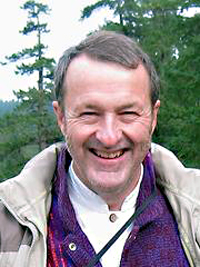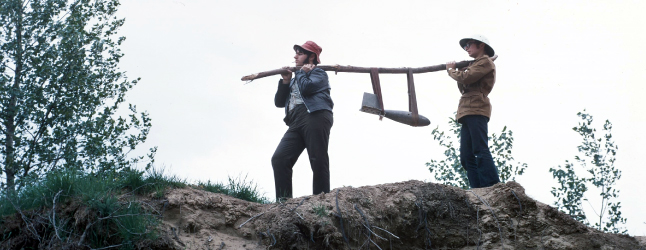
Immediately following the dramatic cablecar rescue, Gordon Jones discovered an object lying under a bush near the tower sketched in last month’s story. Partially buried, it looked very much like an aircraft bomb. I cautioned him not to touch it, but he didn’t pay much attention — I remembered that only a few years before, some Vernon kids had been injured by the explosion of WW II munitions found lying out on the Army range. Then I rationalized, how could a live bomb happen to be lying in the bush of the Jordan River?Upon digging away dead leaves and dirt, we found it was shaped precisely like a snub-nosed bomb, about 80 cm. long, about 15 cm. wide at the head, and tapering to a tail like a fish. At that end it had three fins of aluminum plate. By the weight of it, we figured it must be solid, but there were no screws or plates to see inside. It had a hole running top to bottom through the centre of it, and a slot intersected the hole at right angles through the sides. There was no writing or insignia. It was immediately clear the thing wasn’t explosive, but since it looked precisely like something lost by the military, we christened it “The Bomb.”
We speculated a low-flying aircraft may have dropped it in winter, when snow and frozen ground prevented it from being buried. The explanation for such a drop was unclear, and it certainly couldn’t have been used in avalanche control. Someone suggested perhaps a small radio transmitter in the hole could have enabled ground trackers to later locate it. Maybe they had removed the transmitter and left the weight? Again, the reason for such activity was beyond us, for the only development on the site was the cablecar and the outhouse marked Department of Water Resources. Walt Morello and I had found nothing of interest during our brief isolation to the far side of the river.
Making another use of the life-saving straps, we applied them under the bomb and slung it from a cedar pole. Taking turns, we shouldered its load between us and stumbled back to the Parkinmobile like porters on the Ho Chi Minh trail. This was no easy job, for the beast swung to and fro, and when we later placed it on a scale, it weighed in at 45 kilos (100 pounds). We managed to load our bizarre find into the trunk of the PM and arrived home in time for supper.
That evening we drove around Revelstoke showing The Bomb to everyone we knew. In fact, word spread so fast that people began asking us if they could see it. By then we had our story-telling technique perfected. We concocted a tale of removing the timer and detonator and other dangerous-sounding parts—just how they were supposed to all fit in those two small holes wasn’t clear! Most of our friends listened bug-eyed, and were astonished at our supposed courage. Thus prepared, we would lead the curious over to the PM for “a viewing.”
Gathering around in the dark, we would glance around suspiciously to ensure no one unknown was in the vicinity. I would open the trunk and carefully raise the lid. The Bomb lay in the dim interior enshrouded in a blanket. An expectant hush would fall on the little cluster of teens. With a flourish, I would whip back the cover and Gord would simultaneously beam a flashlight. As that dramatic spotlight hit its metallic flanks, even the most ardent doubters were satisfied: The Bomb held a convincing power. To keep rampant rumours in check, we soon revealed the truth to most folk, but Bruce Tillen went around believing us for several days! Yet no one we asked could satisfactorily explain its mystery.
About a week later, I met a local guy named Dave Williams who said he was ex-Air Force pilot (Dave later painted those steam locomotives formerly around City Hall). He said our device was a dummy bomb, made of lead, and had probably fallen accidentally off a training jet. He explained the finless side was attached to the bottom of the wing, and that the holes were part of its release mechanism. Also, he advised we go to the police about it. This piece of information was rather exciting, and we began to wonder whether we might collect some sort of reward for turning it in. By then we were all getting a bit nervous about handling these ‘hot goods’. Knowing rumours were still rolling around town, we figured it may only be a matter of time before “the fuzz” came to investigate.
Then we learned that lead was worth from forty to fifty cents per pound. Imagine . . . if we could sell our find, that could mean fifty easy dollars! We decided not to be greedy and to sell for $45 so we could each make an even $15.
About this time I learned the Department of Water Resources had an office upstairs in the old Post Office (today housing the Revelstoke Museum & Archives). So Walt and I paid a visit to see whether they could tell us anything. Indeed they could. A guy there explained The Bomb was used in their monitoring of the Jordan River. A current meter was dropped by line from the cablecar at various points across the river to measure depth, velocity, and volume. From these, estimates were made to calculate runoff accumulating in the reservoir downstream. The Bomb was simply a weight which kept that lowered equipment from being carried down in the river’s current. The ‘outhouse’ was technically a water well, housing an automatic device for recording fluctuations in the adjacent river.
The Water Resources guy said the weight had been missing for about a year since someone had broken the chain by which it had been locked onto the tower’s platform. He had not noticed where we found it under a nearby bush. At the time, he said he had gone through a lot of red tape to report its loss.
Since they had obtained a replacement, and since the thing was officially lost (and no reward was mentioned), Walt and I acted nonchalant. We described the place we’d found it, said it was still there, and then got the hell out of that office before anyone asked our names.
This is second of a three-part series which is running in sequence. Watch for Part III: Defusing the Situation in next month’s column.




